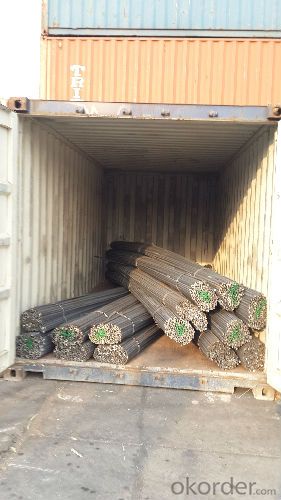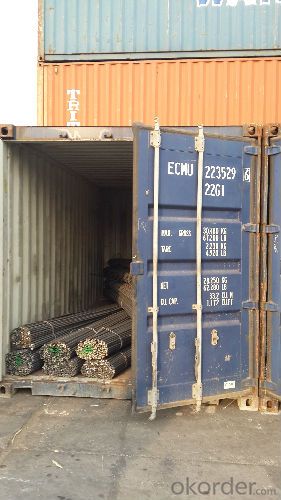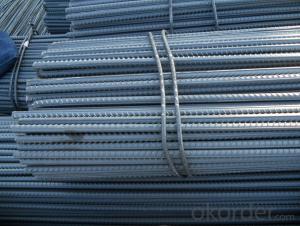Reinforcing Deformed with high quality Steel Bars
- Loading Port:
- Tianjin
- Payment Terms:
- TT or LC
- Min Order Qty:
- 50 m.t
- Supply Capability:
- 20000 m.t/month
OKorder Service Pledge
OKorder Financial Service
You Might Also Like
Product Description:
OKorder is offering Reinforcing Deformed with high quality Steel Bars Building Material China Manufacturer at great prices with worldwide shipping. Our supplier is a world-class manufacturer of steel, with our products utilized the world over. OKorder annually supplies products to European, North American and Asian markets. We provide quotations within 24 hours of receiving an inquiry and guarantee competitive prices.
Product Applications:
Reinforcing Deformed with high quality Steel BarsBuilding Material China Manufacturer are ideal for structural applications and are widely used in the construction of buildings and bridges, and the manufacturing, petrochemical, and transportation industries.
Product Advantages:
OKorder's Reinforcing Deformed with high quality Steel Bars,Building Material China Manufacturer are durable, strong, and resist corrosion.
Main Product Features:
· Mill test certification
· Professional Service
· Competitive pricing
Product Specifications:
HRB400 Deformed Steel Bar Details:
Minimum Order Quantity: | 25MT | Unit: | m.t. | Loading Port: | China Main Port |
Supply Ability: | 800000TONS/YEAR | Payment Terms: | TT or LC |
Product Description:
Specifications of HRB400 Deformed Steel Bar:
Standard | GB | HRB400 | |
Diameter | 6mm,8mm,10mm,12mm,14mm,16mm,18mm,20mm, 22mm,25mm,28mm,32mm,36mm,40mm,50mm | ||
Length | 6M, 9M,12M or as required | ||
Place of origin | Hebei, China mainland | ||
Advantages | exact size, regular package, chemical and mechanical properties are stable. | ||
Type | Hot rolled deformed steel bar | ||
Brand name | DRAGON | ||
Chemical Composition: (Please kindly find our chemistry of our material based on HRB500 as below for your information)
Grade | Technical data of the original chemical composition (%) | ||||||
C | Mn | Si | S | P | V | ||
HRB400 | ≤0.25 | ≤1.60 | ≤0.80 | ≤0.045 | ≤0.045 | 0.04-0.12 | |
Physical capability | |||||||
Yield Strength (N/cm²) | Tensile Strength (N/cm²) | Elongation (%) | |||||
≥400 | ≥570 | ≥14 | |||||
Theoretical weight and section area of each diameter as below for your information:
Diameter(mm) | Section area (mm²) | Mass(kg/m) | Weight of 12m bar(kg) |
6 | 28.27 | 0.222 | 2.664 |
8 | 50.27 | 0.395 | 4.74 |
10 | 78.54 | 0.617 | 7.404 |
12 | 113.1 | 0.888 | 10.656 |
14 | 153.9 | 1.21 | 14.52 |
16 | 201.1 | 1.58 | 18.96 |
18 | 254.5 | 2.00 | 24 |
20 | 314.2 | 2.47 | 29.64 |
22 | 380.1 | 2.98 | 35.76 |
25 | 490.9 | 3.85 | 46.2 |
28 | 615.8 | 4.83 | 57.96 |
32 | 804.2 | 6.31 | 75.72 |
36 | 1018 | 7.99 | 98.88 |
40 | 1257 | 9.87 | 118.44 |
50 | 1964 | 15.42 | 185.04 |
FAQ
Q1: How do we guarantee the quality of our products?
A1: We have established an advanced quality management system which conducts strict quality tests at every step, from raw materials to the final product. At the same time, we provide extensive follow-up service assurances as required.
Q2: How soon can we receive the product after purchase?
A2: Within three days of placing an order, we will begin production. The specific shipping date is dependent upon international and government factors, but is typically 7 to 10 workdays.
Q3: Why buy Materials & Equipment from OKorder.com?
A3: All products offered byOKorder.com are carefully selected from China's most reliable manufacturing enterprises. Through its ISO certifications, OKorder.com adheres to the highest standards and a commitment to supply chain safety and customer satisfaction.
Images:


- Q:What is the tensile strength of a steel rebar?
- The tensile strength of a steel rebar typically ranges from 60,000 to 100,000 pounds per square inch (psi).
- Q:Can steel rebars be used in sports stadium construction?
- Yes, steel rebars can be used in sports stadium construction. Steel rebars are commonly used in the construction of reinforced concrete structures, including sports stadiums. They provide strength and stability to the concrete, ensuring the durability and safety of the stadium.
- Q:What is a steel rebar?
- A steel rebar, also known as reinforcing bar, is a long, cylindrical steel rod or bar that is commonly used in construction projects to reinforce concrete structures. It is embedded within the concrete to enhance its strength and durability, providing resistance against tension and preventing cracking and structural failure.
- Q:Can steel rebars be welded to other steel components?
- Steel rebars have the capability to be welded to other steel components. In construction projects, welding serves as a common method for connecting steel rebars to various steel structures or components. This procedure involves heating the rebars and steel components to a high temperature, causing them to melt. Following this, they are allowed to cool and solidify, resulting in a strong and durable bond. Welding steel rebars to other steel components is widely accepted and contributes to the overall integrity and stability of the construction. By ensuring a dependable connection, it enables the rebars and steel components to effectively withstand external forces and loads. However, it is crucial to employ proper welding techniques and adhere to relevant industry standards and guidelines to guarantee a successful and safe welding process.
- Q:What are the guidelines for the proper anchoring of steel rebars in columns?
- To guarantee the structural integrity and safety of reinforced concrete structures, it is crucial to adhere to guidelines regarding the appropriate anchoring of steel rebars in columns. These guidelines are typically established based on industry standards and codes, such as the American Concrete Institute (ACI) Building Code Requirements for Structural Concrete (ACI 318). 1. Lap Length: For sufficient bond strength, rebars must overlap by a minimum distance known as the lap length. This length is determined considering factors like rebar diameter, grade, concrete strength, and design requirements. To calculate the required lap length, specific formulas and tables provided by ACI 318 are used. 2. Embedment Length: The embedment length refers to the section of the rebar embedded within the concrete column. Achieving adequate embedment is essential to effectively transfer applied loads. The embedment length is determined based on factors such as rebar diameter, grade, and compressive strength of concrete. 3. Development Length: The development length is the minimum length of rebar needed beyond the critical section to fully develop its tensile or compressive strength. This ensures the rebar can withstand applied loads and avoid premature failure. ACI 318 provides formulas to calculate the development length considering rebar diameter, grade, concrete strength, and design requirements. 4. Concrete Cover: Concrete cover refers to the thickness of concrete between the rebar's external surface and the column's outer surface. It provides protection against corrosion, fire, and environmental factors. The required concrete cover is determined by considering factors like rebar diameter, grade, exposure conditions, and design requirements. ACI 318 provides minimum cover requirements for different rebar sizes and exposure conditions. 5. Spacing and Positioning: Proper spacing and positioning of rebars within the column are crucial to ensure uniform load distribution and effective reinforcement. The spacing is determined based on column dimensions, rebar diameter, and design requirements. Additionally, rebars should be properly aligned and centered within the column to achieve the intended structural strength. 6. Mechanical Anchorage: In certain cases, mechanical anchorage devices like rebar couplers or headed bars are employed to enhance rebar anchoring in columns. These devices improve load transfer and prevent rebar slippage. The selection and installation of mechanical anchorage should adhere to the manufacturer's recommendations and relevant standards. 7. Quality Control and Inspection: Implementing proper quality control and inspection procedures during rebar installation in columns is crucial. This involves verifying dimensions, lap lengths, embedment lengths, development lengths, concrete cover, spacing, and positioning of the rebars. Regular inspections and non-destructive testing techniques such as ultrasonic or radiographic testing can be utilized to ensure compliance with guidelines and identify any defects or deviations. It is important to note that these guidelines may vary based on specific design requirements, local building codes, and structural considerations. Therefore, it is recommended to consult relevant standards and seek professional advice from structural engineers or experts to ensure proper anchoring of steel rebars in columns.
- Q:Can steel rebars be used in high-temperature applications?
- No, steel rebars should not be used in high-temperature applications as they can lose their strength and structural integrity due to thermal expansion and potential oxidation.
- Q:Can steel rebars be used in structures with high vibrations?
- Yes, steel rebars can be used in structures with high vibrations. Steel rebars are commonly used in construction projects, including those with high vibrations, to reinforce concrete and provide stability. The strong and durable nature of steel rebars helps to absorb and distribute the vibrations, minimizing any potential damage to the structure. However, it is important to ensure that the design and installation of steel rebars are done correctly to effectively withstand and manage the vibrations.
- Q:How do steel rebars prevent concrete from cracking?
- Steel rebars prevent concrete from cracking by providing tensile strength to the structure. When concrete is subjected to external forces or loads, it tends to crack due to its low tensile strength. However, by reinforcing it with steel rebars, the concrete becomes more resistant to cracking. The rebars act as structural reinforcement, absorbing the tensile forces and distributing them throughout the concrete, preventing cracks from forming and ensuring the overall stability and durability of the structure.
- Q:Are steel rebars suitable for use in historical restoration projects?
- Yes, steel rebars can be suitable for use in historical restoration projects. They provide structural reinforcement and can help strengthen deteriorated or weakened elements of historical buildings. However, careful consideration should be given to ensure that the use of steel rebars aligns with the original materials and techniques used in the construction of the historical structure. Additionally, the visual impact and authenticity of the restored elements should be taken into account, as steel rebars may not always be ideal for maintaining the historical integrity of the building.
- Q:How do steel rebars affect the constructability of complex architectural designs?
- Steel rebars play a crucial role in the constructability of complex architectural designs. These reinforced bars provide structural integrity and strength to concrete elements, making it possible to create intricate and innovative designs. Firstly, steel rebars allow architects to design structures with larger spans and heights, as they provide the necessary load-bearing capacity. This is particularly important in complex designs that involve cantilevers, soaring roofs, or suspended floors, as the rebars distribute the loads evenly and prevent structural failure. Moreover, steel rebars enhance the constructability of complex architectural designs by enabling the creation of slender and lightweight structures. Since rebars are strong and durable, they can be used to reinforce thin concrete elements, reducing the overall weight of the structure. This not only enhances the aesthetic appeal of the design but also minimizes the amount of material required, resulting in cost savings during construction. In addition, steel rebars offer flexibility during the construction process. They can be easily bent and shaped to match the intricate geometries and curves of complex architectural designs. This allows architects to realize their creative vision by incorporating unique and eye-catching elements into the structure. Furthermore, steel rebars contribute to the durability and longevity of complex architectural designs. By reinforcing the concrete, they increase its resistance to cracking, bending, and corrosion. This is especially important in areas prone to seismic activity or harsh weather conditions. The use of rebars ensures that the structure can withstand these challenges and remain intact over time. Overall, steel rebars significantly impact the constructability of complex architectural designs. Their strength, versatility, and ability to reinforce concrete elements make it possible to create innovative structures that are both visually appealing and structurally sound. Without the support of steel rebars, the construction of such complex designs would be much more challenging, if not impossible.
1. Manufacturer Overview |
|
|---|---|
| Location | |
| Year Established | |
| Annual Output Value | |
| Main Markets | |
| Company Certifications | |
2. Manufacturer Certificates |
|
|---|---|
| a) Certification Name | |
| Range | |
| Reference | |
| Validity Period | |
3. Manufacturer Capability |
|
|---|---|
| a)Trade Capacity | |
| Nearest Port | |
| Export Percentage | |
| No.of Employees in Trade Department | |
| Language Spoken: | |
| b)Factory Information | |
| Factory Size: | |
| No. of Production Lines | |
| Contract Manufacturing | |
| Product Price Range | |
Send your message to us
Reinforcing Deformed with high quality Steel Bars
- Loading Port:
- Tianjin
- Payment Terms:
- TT or LC
- Min Order Qty:
- 50 m.t
- Supply Capability:
- 20000 m.t/month
OKorder Service Pledge
OKorder Financial Service
Similar products
New products
Hot products
Related keywords





























